The Carbonate-Hosted Tullacondra Cu-Ag Deposit, Mallow, Ireland
Abstract
1. Introduction
2. Geological Setting
2.1. Carbonate-Hosted Zn-Pb and Cu-Ag Mineralization in Ireland
2.2. The Tullacondra Deposit
2.2.1. Stratigraphy
2.2.2. Structural Geology
2.2.3. Mineralization
3. Materials and Methods
4. Results
4.1. Geological Modelling
- Mineralized zone 1 (Transition Series-hosted mineralized zone): the mineralized zone 1 is defined as a stratabound lens located between the Lower and Upper Transition Series. The main host rocks are calcareous sandstone and shale, and sandy calcarenite. It averages 150 ppm Ag and 0.6% Cu, according to [6], and hosts the highest Ag grades, mainly in the southern part of the deposit (up to 383 ppm Ag). In this mineralized zone, the sulfides and sulfosalts (Figure 4) are zoned: (a) limited between the NS-trending faults consisting of tennantite–tetrahedrite-arsenopyrite-chalcopyrite > bornite–chalcocite (Figure 4D,E) and (b) beyond the limit of these faults containing tennantite–tetrahedrite-arsenopyrite > chalcopyrite (Figure 4C,F);
- Mineralized zone 2 (Lower Limestone Shale-hosted mineralized zone): This mineralized zone averages 30 ppm Ag and 0.7% Cu and is hosted in the sub-units of the L.L.S. The main host rocks are calcareous shale or shaly calcarenite, but the mineralization is also hosted locally in massive calcarenite. In contrast to mineralized zone 1, the mineralized zone 2 lacks sulfide zonation and is characterized by chalcopyrite–bornite–chalcocite > tennantite–tetrahedrite-arsenopyrite, and traces of pyrite;
- Mineralized zone 3 (Near-vertical mineralized zone): This zone consists of Cu grades between 0.2 and 0.7% and Ag grades between 14 and 30 ppm (Figure 4D,E). The ore mineralogy of this zone varies according to the host rocks. At the intersection of the mineralized zone 3 and the Transition Series, As minerals predominate. Where zone 3 intersects the L.L.S., Cu sulfides predominate, as observed in the mineralized zone 2.
4.2. Petrography
4.3. Sulfides and Sulfosalts Texture
- Disseminated and bedding-parallel sulfides and sulfosalts: Disseminated and bedding-parallel sulfides are pervasive throughout the Tullacondra deposit and represent the main ore texture, characterized by fine- to medium-grained chalcocite, bornite, chalcopyrite, and pyrite. Disseminated textures are observed within (dolomitized) calcarenite and sandstone, and Cu and As sulfide and sulfosalts replace bioclasts and oolites and infill pores (Figure 6A–C); in contrast, bedding-parallel sulfides are associated with shaly units in which sulfides occur along bedding planes (Figure 6D–F). Both textures contain sulfide and sulfosalts overprinting carbonate grains or cement. Disseminated and bedding-parallel textures are also common and spatially associated with zones of dissolution seams-hosted sulfides and sulfosalts.
- Dissolution seam-hosted sulfides and sulfosalts: Dissolution seam-hosted sulfides and sulfosalts are in general more sulfide/sulfosalts-rich (up to 5%) compared to disseminated and bedding-parallel textures (Table A2). Dissolution surfaces occur closely spaced in shaly calcarenite and shale and spaced at 1 to 5 cm in calcarenite and calcareous sandstone. They are mostly mineralized to barren, bedding-parallel anastomosing dissolution seams (non-serrated) and subordinate barren seams (serrated). These seams are usually up to 1 cm thick (thicker in some cases) and are filled by very fine- to fine-grained quartz, phyllosilicates, traces of very fine-grained oxides, and organic matter (bitumen). Additionally, they are continuous bifurcate around, not cutting clasts, or cut calcite clasts (Figure 7A–C). Some calcite clasts are flattened and locally show slight asymmetry. The medium-grained mica is often within the seams and shows a preferred bedding-parallel orientation (Figure 7D). Dissolution seams can evolve to incipient breccias characterized by fine-grained matrix surrounding calcitic clasts and, in the western area, surrounding partially dolomitized clasts (Figure 7E,F). These clasts are fine- to coarse-grained and subrounded to subangular with sharp to irregular contact with the matrix. Ore minerals commonly occur along dissolution seams and within breccias on the boundaries between calcitic clasts and matrix.
- Vein-hosted: Vein-hosted sulfides and sulfosalts are characterized by anhedral, coarse- to fine-grained ore minerals within medium-grained sparitic calcite, ferroan dolomite, and quartz veins that are approximately up to 1 cm thick, although they can be locally thicker (Figure 8A–D). These veins cut through the other ore textures (disseminated, bedding-parallel, and dissolution-hosted ore minerals) but contain the same ore mineral and gangue assemblage as the mineralized host rock. The vein-hosted sulfides occur mainly along the vein wall, but they also form disseminations within the veins. Regarding their orientation, veins are usually steeply dipping bedding-oblique, and stockwork veins are common close to the Tullacondra Fault, and dolomite veins are usually parallel to calcite veins. Ore minerals within veins and close to dissolution seams usually develop a parallel orientation to the seams.
4.4. Geochemistry
5. Discussion
5.1. Host Rocks and Post-Depositional Events
5.2. Ore Formation Controls
5.3. Paragenetic Sequence
5.4. Genetic Model
6. Conclusions
- Pre-ore stage: this stage is characterized by the onset of EW-trending faulting (Tullacondra Fault). The formation of the Tullacondra Fault likely resulted in subsidiary faults and fractures, which later would serve as conduits for mineralizing fluids.
- The Main-ore stage is characterized by the deposition of the sulfides and the formation of the mineralized zones 1 and 2. The fluid flowed laterally and upwards along the Tullacondra fault, precipitating sulfides and sulfosalts along stratigraphic boundaries. Variations of sulfide composition are attributed to two distinct mineralizing pulses, an earlier Cu- and Ag-bearing fluid and a later Cu- and As-bearing fluid.
- The late-ore stage is marked by the remobilization of metals in sparitic calcite and dolomite veins, forming the vertical mineralized zone. The timing of this stage is unknown, and we are unable to establish whether it shortly post-dates the main ore stage or if it is associated with an even later stage, such as the Hercynian compression.
Supplementary Materials
Author Contributions
Funding
Institutional Review Board Statement
Informed Consent Statement
Data Availability Statement
Acknowledgments
Conflicts of Interest
Appendix A
| Lithological Units | Thickness | Description | ||
|---|---|---|---|---|
| LOWER CARBONIFEROUS (CORCEYAN) | Kilmaclenine Ls | 100 m | Pale grey, thick-bedded bioclastic limestone, often shale free | |
| Tullacondra Ls | 35 m | Medium grey, crinoidal with thin irregular shale partings, siliciclastic at the base | ||
| Ballyvergin Shale | 1 m | Fine, sandy, non-calcareous, green-grey siltstone | ||
| LOWER LIMESTONE SHALE | Upper Shaly Calcarenite | 15–20 m | Medium grey crinoidal calcarenite, abundant shale partings, siliceous at the top | |
| Silty Calcarenite | 2 m | Dark grey muddy calcarenite | ||
| Oolitic Calcarenite | 9–12 m | Interbedded oolites and crinoidal calcarenites | ||
| Lower Shaly Calcarenite | 6–9 m | Uniform, pale calcarenite with interbedded, shaly crinoidal units | ||
| Uniform Calcarenite | 5–6 m | Pale massive calcarenite, mostly shale free | ||
| Upper (Shaly) Transition Series | 12–15 m | Black shales, sandy calcarenites, and sandstones −0.3 m Hematitic Horizon near the base | ||
| Lower (Sandy) Transition Series | 12–15 m | Sandstones, shales, and conglomerates, often calcareous | ||
| DEVONIAN | Old Red Sandstone | >500 m | Shales, quartzitic sandstones, conglomerates, and red beds | |
| Samples | Area | Units | Texture | Ore Mineralagy | % Ore Minerals |
|---|---|---|---|---|---|
| M73-3-027 | Western area | Tullacondra Ls | - | supergene minerals | - |
| M73-3-039 | Western area | Tullacondra Ls | disseminated/vein-hosted | ccp, cct, bn >> py | 2% |
| M73-3-069 | Western area | Tullacondra Ls | - | supergene minerals | - |
| M73-3-094 | Western area | Tullacondra Ls | disseminated/vein-hosted | cct, bn >> py | 2% |
| M73-3-119 | Western area | Ballyvergin Shale | bedding-paralel/dissolution seam-hosted/vein-hosted | cct, bn, ccp | 3% |
| M73-3-132 | Western area | Lower Ls Shale | disseminated/dissolution seam-hosted | cct, bn, ccp > tnt, apy | 2% |
| M73-3-143 | Western area | Lower Ls Shale | disseminated/dissolution seam- hosted | cct, bn, ccp > tnt, apy | 5% |
| M73-3-154 | Western area | Lower Ls Shale | disseminated/dissolution seam-hosted | cct, bn, ccp > tnt, apy | 3% |
| M73-3-162 | Western area | Lower Ls Shale | disseminated/dissolution seam-hosted | cct, bn, ccp > tnt, ttr, apy | 5% |
| M73-3-196 | Western area | Lower Ls Shale | disseminated | ccp > tnt, apy | 3% |
| M73-3-203 | Western area | Lower Ls Shale | disseminated | ccp > tnt, apy | 1% |
| M73-3-218 | Western area | Lower Ls Shale | disseminated | ccp > tnt, apy | 1% |
| Samples | Area | Units | Texture | Ore mineralagy | % ore minerals |
| M73-3-233 | Western area | Lower Ls Shale | disseminated/dissolution seam-hosted | ccp > tnt, apy | 2% |
| M73-3-241 | Western area | Lower Ls Shale | disseminated | ccp | <1% |
| M73-3-283 | Western area | Lower Ls Shale | disseminated | ccp | <1% |
| M73-3-293 | Western area | Lower Ls Shale | disseminated | ccp | <1% |
| M73-3-318 | Western area | Lower Ls Shale | disseminated/dissolution seam-hosted | ccp, tnt > apy | 3% |
| M73-3-328 | Western area | Lower Ls Shale | disseminated/dissolution seam-hosted | ccp, tnt > apy | 3% |
| M73-3-347 | Western area | Lower Ls Shale | disseminated | ccp > tnt, apy | 1% |
| M73-3-374 | Western area | Transition Series | disseminated | ccp > tnt, apy | <1% |
| M73-3-393 | Western area | Transition Series | vein-hosted | ccp, tnt, ttr > apy | 3% |
| M73-11-290 | Central area | Lower Ls Shale | disseminated/dissolution seam-hosted | Py | 2% |
| M73-11-296 | Central area | Lower Ls Shale | disseminated/bedding-paralel/dissolution seam-hosted | Bn >> cct, ccp >tnt | 2% |
| M73-11-310 | Central area | Lower Ls Shale | disseminated/dissolution seam-hosted | bn, ccp > tnt | 1% |
| M73-11-319 | Central area | Lower Ls Shale | disseminated/dissolution seam-hosted | Ccp >> bn, tnt | 1% |
| M73-11-336 | Central area | Lower Ls Shale | disseminated | Ccp >bn, tnt | <1% |
| M73-11-347 | Central area | Lower Ls Shale | disseminated | Bn >> cct, ccp > tnt | <1% |
| M73-11-359 | Central area | Lower Ls Shale | disseminated/vein-hosted | cct, bn >> tnt | 1% |
| M73-11-389 | Central area | Lower Ls Shale | vein-hosted | bn, ccp | <1% |
| M73-11-404 | Central area | Lower Ls Shale | disseminated | Ccp > bn, tnt | <1% |
| M73-11-422 | Central area | Transition Series | disseminated/bedding-paralel/dissolution seam-hosted/vein-hosted | Bn >> ccp, tnt > apy | 5% |
| M73-11-442 | Central area | Transition Series | disseminated/vein-hosted | bn, ccp, tnt > apy | 2% |
| M73-11-450 | Central area | Transition Series | disseminated | bn, ccp, tnt > apy | 1% |
| M73-11-510 | Central area | Old Red Sandsone | disseminated/vein-hosted | - | <1% |
| M73-19-72 | Eastern area | Lower Ls Shale | disseminated/dissolution seam-hosted/vein-hosted | cct, bn, ccp | 5% |
| M73-19-133 | Eastern area | Lower Ls Shale | disseminated/dissolution seam-hosted/vein-hosted | cct, bn, ccp >> tnt, ttr > py | 5% |
| M73-19-142 | Eastern area | Lower Ls Shale | disseminated/vein-hosted | cct, bn, ccp >> tnt | 2% |
| M7319-172 | Eastern area | Lower Ls Shale | disseminated/dissolution seam-hosted/vein-hosted | cc, bn, ccp | 2% |
| M73-19-249 | Eastern area | Transition Series | disseminated/dissolution seam-hosted/vein-hosted | tnt >> cc, bn, ccp | 3% |
| M73-19-257 | Eastern area | Transition Series | disseminated | tnt >> cc, bn, ccp | 2% |
| M73-19-264 | Eastern area | Transition Series | disseminated | tnt >> cc, bn, ccp | 2% |
| M73-19-271 | Eastern area | Transition Series | disseminated | tnt >> cc, bn, ccp | 2% |
| M7319-279 | Eastern area | Transition Series | disseminated | tnt >> cc, bn, ccp | 2% |
| M73-19-296 | Eastern area | Transition Series | disseminated | tnt | 1% |
| Samples | Petrog. | EDS | Assay | micro-XRF | SiO2 (%) | Al2O3 (%) | CaO (%) | MgO (%) | K2O (%) | TiO2 (%) | Cu (ppm) | Ag (ppm) | As (ppm) | Sb (ppm) | S (%) | ||
| M73-3-027 | Tullacondra Ls | X | X | 7.29 | 1.1 | 28.3 | 17.55 | 0.41 | 0.05 | 5130 | <0.5 | 4.2 | 2 | <0.01 | |||
| M73-3-039 | Tullacondra Ls | X | X | 5 | 0.76 | 50.1 | 0.57 | 0.28 | 0.03 | >10,000 | 20.2 | 8.6 | 14.6 | 0.19 | |||
| M73-3-069 | Tullacondra Ls | X | X | 7.21 | 0.27 | 51.6 | 0.48 | 0.12 | 0.01 | 463 | 0.5 | 11.5 | 0.73 | 0.03 | |||
| M73-3-094 | Tullacondra Ls | X | X | X | X | 38.5 | 0.5 | 34.1 | 0.38 | 0.19 | 0.02 | 782 | 3.1 | 0.9 | 0.17 | 0.07 | |
| M73-3-119 | Ballyvergin Shale | X | X | X | X | 61.1 | 15.1 | 6.13 | 1.33 | 4.91 | 0.78 | 9000 | 46.6 | 8.3 | 0.39 | 0.37 | |
| M73-3-132 | Upper Shaly Calcarenite | X | X | 23 | 2.28 | 40 | 0.88 | 0.71 | 0.09 | 3510 | 14.5 | 2.1 | 0.22 | 0.25 | |||
| M73-3-143 | Upper Shaly Calcarenite | X | X | 69.1 | 8.01 | 9.59 | 0.72 | 2.56 | 0.33 | >10,000 | 1.4 | 44.3 | 1.93 | 1.1 | |||
| M73-3-154 | Upper Shaly Calcarenite | X | X | X | 26.4 | 3.67 | 35.7 | 0.75 | 1.19 | 0.16 | 2450 | 13.1 | 80.6 | 12.35 | 0.17 | ||
| M73-3-162 | Upper Shaly Calcarenite | X | X | X | X | 39.2 | 7.56 | 20.1 | 4.9 | 2.51 | 0.31 | 4010 | 3.7 | 97.6 | 77 | 0.33 | |
| M73-3-196 | Upper Shaly Calcarenite | X | X | X | X | 7.38 | 1.06 | 28.4 | 18.7 | 0.35 | 0.06 | 6930 | 0.7 | 8 | 4.4 | 0.44 | |
| M73-3-203 | Upper Shaly Calcarenite | X | X | 3.83 | 0.71 | 29.9 | 19.55 | 0.25 | 0.02 | 1650 | <0.5 | 3.9 | 0.63 | 0.08 | |||
| M73-3-218 | Upper Shaly Calcarenite | X | X | X | 7.42 | 1.08 | 28.3 | 17.7 | 0.35 | 0.04 | 654 | <0.5 | 1.7 | 0.22 | 0.03 | ||
| M73-3-233 | Upper Shaly Calcarenite | X | X | X | 63 | 15.5 | 3.32 | 2.89 | 4.74 | 0.83 | 2470 | <0.5 | 70.2 | 0.7 | 0.28 | ||
| M73-3-241 | Upper Shaly Calcarenite | X | X | 8.94 | 0.63 | 28.2 | 17.05 | 0.24 | 0.04 | 65 | <0.5 | 4 | 0.32 | 0.02 | |||
| M73-3-254 | Upper Shaly Calcarenite | X | X | X | 58.8 | 20.4 | 0.39 | 2.14 | 5.89 | 0.92 | 41 | <0.5 | 28.7 | 0.64 | 0.41 | ||
| M73-3-283 | Oolitic Calcarenite | X | X | X | 9.58 | 0.54 | 27.8 | 17.1 | 0.23 | 0.02 | 9 | <0.5 | 48.5 | 0.66 | 0.14 | ||
| M73-3-293 | Oolitic Calcarenite | X | X | X | 18 | 2.25 | 24 | 15 | 0.77 | 0.11 | 21 | <0.5 | 2 | 0.09 | 0.04 | ||
| M73-3-318 | Lower Shaly Calcarenite | X | X | X | 52.1 | 13.45 | 8.85 | 2.79 | 4.3 | 0.61 | 7120 | <0.5 | 13.2 | 0.9 | 0.73 | ||
| M73-3-328 | Lower Shaly Calcarenite | X | X | X | X | 57.7 | 12.9 | 5.46 | 3.89 | 4.22 | 0.57 | >10,000 | <0.5 | 22.2 | 1.15 | 1.25 | |
| M73-3-347 | Uniform Calcarenite | X | X | X | 81.8 | 8.26 | 0.79 | 0.51 | 2.71 | 0.53 | 9830 | 1.7 | 72.7 | 25.6 | 1.1 | ||
| M73-3-364 | Upper Transition Series | X | X | 62.9 | 3.5 | 8.91 | 5.88 | 1.19 | 0.47 | 3510 | 2.4 | 15 | 0.76 | 0.23 | |||
| M73-3-374 | Upper Transition Series | X | X | X | 66 | 6.76 | 6.39 | 4.47 | 2.25 | 0.35 | 1350 | <0.5 | 23.6 | 5.99 | 0.14 | ||
| M73-3-393 | Lower Transition Series | X | X | X | X | 50.2 | 11.9 | 7.5 | 5.61 | 3.89 | 0.61 | >10,000 | 1.5 | >250 | >250 | 1.64 | |
| M73-3-412 | Lower Transition Series | X | X | X | 90.5 | 4.24 | 0.82 | 0.66 | 1.42 | 0.2 | 18 | <0.5 | 0.5 | 0.12 | 0.01 | ||
| M73-11-290 | Upper Shaly Calcarenite | X | X | X | 27.2 | 6.58 | 31.5 | 1.43 | 1.95 | 0.27 | 15 | <0.5 | >250 | 1.07 | 0.49 | ||
| M73-11-296 | Upper Shaly Calcarenite | X | X | 60.9 | 8.17 | 12.1 | 0.9 | 2.37 | 0.34 | 5250 | 45 | 17.2 | 0.13 | 0.32 | |||
| M73-11-310 | Upper Shaly Calcarenite | X | 35.1 | 8.67 | 22.9 | 1.43 | 2.64 | 0.38 | >10,000 | >100 | 22.4 | 0.07 | 1.13 | ||||
| M73-11-319 | Upper Shaly Calcarenite | X | X | X | 5.79 | 0.89 | 51 | 0.65 | 0.28 | 0.05 | 1520 | 0.9 | 12.9 | 0.47 | 0.33 | ||
| Samples | Petrog. | EDS | Assay | micro-XRF | SiO2 (%) | Al2O3 (%) | CaO (%) | MgO (%) | K2O (%) | TiO2 (%) | Cu (ppm) | Ag (ppm) | As (ppm) | Sb (ppm) | S (%) | ||
| M73-11-336 | Oolitic Calcarenite | X | X | 17.45 | 3.07 | 41.2 | 1.1 | 0.91 | 0.13 | 375 | <0.5 | 16.2 | 0.16 | 0.09 | |||
| M73-11-347 | Oolitic Calcarenite | X | X | 7.59 | 0.97 | 50.2 | 0.61 | 0.33 | 0.05 | 6420 | 30 | 3.7 | 0.06 | 0.28 | |||
| M73-11-359 | Oolitic Calcarenite | X | X | 5.27 | 0.8 | 50.7 | 0.82 | 0.29 | 0.03 | 2540 | 8 | 4.3 | 0.24 | 0.13 | |||
| M73-11-404 | Uniform Calcarenite | X | X | 7.33 | 0.86 | 49.1 | 1.05 | 0.3 | 0.05 | 843 | 0.6 | 15.1 | 0.1 | 0.13 | |||
| M73-11-422 | Upper Transition Series | X | X | 32 | 7.62 | 26.3 | 1.63 | 2.58 | 0.39 | >10,000 | 57.6 | 10.3 | 0.23 | 0.6 | |||
| M73-11-431 | Upper Transition Series | X | 29.7 | 1.4 | 31.5 | 1.67 | 0.1 | 0.08 | 1070 | 1 | 0.5 | 0.07 | 0.11 | ||||
| M73-11-442 | Lower Transition Series | X | 71 | 10.4 | 4.71 | 0.63 | 3.42 | 0.51 | >10,000 | >100 | >250 | >250 | 0.89 | ||||
| M73-11-450 | Lower Transition Series | X | 86.4 | 6.06 | 0.97 | 0.14 | 2.56 | 0.17 | 5910 | 26 | 155.5 | 3.25 | 0.28 | ||||
| M73-11-498 | Old Red Sandstone | X | X | X | 52.6 | 9.46 | 6.28 | 1.21 | 3.51 | 0.55 | 13 | <0.5 | 1.6 | 0.37 | 2.18 | ||
| M73-11-510 | Old Red Sandstone | X | X | 65.6 | 3.55 | 8.19 | 1.31 | 1.48 | 0.14 | 6 | <0.5 | 0.7 | <0.05 | 1.46 | |||
| M73-19-072 | Oolitic Calcarenite | X | X | X | 18.05 | 4.32 | 41.8 | 0.79 | 1.33 | 0.24 | 8460 | 12.3 | 9.5 | 2.29 | 0.99 | ||
| M73-19-133 | Lower Shaly Calcarenite | X | X | X | X | 13.05 | 1.45 | 46.2 | 0.67 | 0.49 | 0.09 | >10,000 | 79 | 10.2 | 0.27 | 0.56 | |
| M73-19-142 | Lower Shaly Calcarenite | X | |||||||||||||||
| M73-19-172 | Uniform Calcarenite | X | |||||||||||||||
| M73-19-249 | Lower Transition Series | X | X | X | 75.1 | 11.8 | 0.91 | 0.58 | 3.95 | 0.68 | >10,000 | 95.5 | >250 | >250 | 0.66 | ||
| M73-19-257 | Lower Transition Series | X | X | X | X | 75.9 | 11.05 | 1.87 | 0.94 | 3.77 | 0.56 | 7050 | 45.3 | >250 | 146.5 | 0.38 | |
| M73-19-264 | Lower Transition Series | X | |||||||||||||||
| M73-19-271 | Lower Transition Series | X | |||||||||||||||
| M73-19-279 | Lower Transition Series | X | |||||||||||||||
| M73-19-296 | Lower Transition Series | X | X | 87.2 | 3.63 | 4.03 | 0.43 | 1.74 | 0.06 | 1280 | 3.6 | >250 | 119 | 0.08 |
References
- Singer, D.A. World class base and precious metal deposits—A quantitative analysis. Econ. Geol. 1995, 90, 88–104. [Google Scholar] [CrossRef]
- Andrew, C.J. The tectono-stratigraphic controls to mineralization in the Silvermines area, County Tipperary, Ireland. In Geology and Genesis of Mineral Deposits in Ireland; Andrew, C.J., Crowe, R.W.A., Finlay, S., Pennel, W.M., Pyne, J.F., Eds.; Irish Association for Economic Geology: Dublin, Ireland, 1986; pp. 377–417. [Google Scholar]
- Shearley, E.; Redmon, P.; King, M.; Goodman, R. Geological controls on mineralization and dolomitization of the Lisheen Zn-Pb-Ag deposit, Co. Tipperary, Ireland. Geol. Soc. Lond. Spec. Publ. 1996, 107, 23–33. [Google Scholar] [CrossRef]
- Ashton, J.H.; Blakeman, R.J.; Geraghty, J.F.; Beach, A.; Coller, D.; Philcox, M.E.; Boyce, A.J.; Wilkinson, J.J. The Giant Navan Carbonate-Hosted Zn-Pb Deposit—A review. In Current Perspectives on Zinc Deposits; Archibald, S.M., Piercey, S.J., Eds.; Irish Association for Economic Geology: Dublin, Ireland, 2015; pp. 85–122. ISBN 978-0-9509894-5-7. [Google Scholar]
- Steed, G.M. The geology and genesis of the Gortdrum Cu-Ag-Hg orebody. In Geology and Genesis of Mineral Deposits in Ireland; Andrew, C.J., Crowe, R.W.A., Finlay, S., Pennel, W.M., Pyne, J.F., Eds.; Irish Association for Economic Geology: Dublin, Ireland, 1986; pp. 481–499. [Google Scholar]
- Wilbur, D.G.; Carter, J.S. Cu-Ag mineralization at Tullacondra, Mallow, Co. Cork. In Geology and Genesis of Mineral Deposits in Ireland; Andrew, C.J., Crowe, R.W.A., Finlay, S., Pennel, W.M., Pyne, J.F., Eds.; Irish Association for Economic Geology: Dublin, Ireland, 1986; pp. 501–507. [Google Scholar]
- Phillips, W.E.A.; Sevastopulo, G.D. The stratigraphic and structural setting of Irish mineral deposits. In Geology and Genesis of Mineral Deposits in Ireland; Andrew, C.J., Crowe, R.W.A., Finlay, S., Pennel, W.M., Pyne, J., Eds.; Irish Association for Economic Geology: Dublin, Ireland, 1986; pp. 1–30. [Google Scholar]
- Soper, N.J. Timing and geometry of collision, terrane accretion and sinistral strike-slip events in the British Caledonides. In The Caledonian—Appalachian Orogen; Harris, A.L., Fettes, D.J., Eds.; Geological Society Special Publication: London, UK, 1988; Volume 38, pp. 481–492. [Google Scholar]
- Wilkinson, J.J. Sediment-Hosted Zinc-Lead Mineralization: Processes and Perspectives: Processes and Perspectives. In Treatise on Geochemistry: Second Edition; Elsevier Ltd.: Amsterdam, The Netherlands, 2013; Volume 13, pp. 219–249. ISBN 9780080983004. [Google Scholar]
- Hudson, R.G.S.; Philcox, M.E. The Lower Carboniferous Stratigraphy of the Buttevant Area, Co. Cork. Proc. R. Ir. Acad. 1964, 64, 65–79. [Google Scholar]
- Gardiner, P.R.R.; Maccarthy, I.A.J. The late Palaeozoic evolution of southern Ireland in the context of tectonic basins and their trans-Atlantic significance. In Geology of the North Atlantic Borderlands; Kerr, J.W., Fergus, A.J., Eds.; Memoir of the Canadian Society of Petroleum Geologists: Calgary, AB, Canada, 1981; Volume 7, pp. 683–725. [Google Scholar]
- Anderson, I.K.; Ashton, J.H.; Boyce, A.J.; Fallick, A.E.; Russell, M.J. Ore Depositional Processes in the Navan Zn-Pb Deposit, Ireland. Econ. Geol. 1998, 93, 535–563. [Google Scholar] [CrossRef]
- Somerville, I.D.; Jones, G.L.I. The Courceyan stratigraphy of the Pallaskenry Borehole, County Limerick, Ireland. Geol. J. 1985, 20, 377–400. [Google Scholar] [CrossRef]
- Somerville, I.D.; Strogen, P.; Jones, G.L. Biostratigraphy of Dinantian limestones and associated volcanic rocks in the Limerick Syncline, Ireland. Geol. J. 1992, 27, 201–220. [Google Scholar] [CrossRef]
- Strogen, P.; Somerville, I. The stratigraphy of the Upper Palaeozoic rocks of the Lyons Hill area, county Kildare. Ir. Assoc. Econ. Geol. 1984, 6, 155–173. [Google Scholar]
- Lees, A.; Miller, J. Facies variation in Waulsortian buildups, Part 2; Mid-Dinantian buildups from Europe and North America. Geol. J. 1985, 20, 159–180. [Google Scholar] [CrossRef]
- Gregg, J.M.; Shelton, K.L.; Johnson, A.W.; Somerville, I.D.; Wright, W.R. Dolomitization of the Waulsortian Limestone (Lower Carboniferous) in the Irish Midlands. Sedimentology 2001, 48, 745–766. [Google Scholar] [CrossRef]
- Mccusker, J.; Reed, C. The role of intrusions in the formation of Irish-type mineralisation. Miner. Depos. 2013, 48, 687–695. [Google Scholar] [CrossRef]
- Wilkinson, J.J.; Hitzman, M.W. The Irish Zn-Pb Orefield: The View from 2014. Ir. Assoc. Econ. Geol. 2015, 59–72. [Google Scholar]
- Elliott, H.A.L.; Gernon, T.M.; Roberts, S.; Boyce, A.J.; Hewson, C. Diatremes act as fluid conduits for Zn-Pb mineralization in the SW Irish ore field. Econ. Geol. 2019, 114, 117–125. [Google Scholar] [CrossRef]
- Coller, D.W. Variscan structures in the Upper Palaeozoic rocks of west central Ireland. In Variscan Tectonics of the North Atlantic Region; Hutton, D.J., Sanderson, D.H.W., Eds.; Geological Society of London Special Publication: London, UK, 1984; Volume 14, pp. 185–194. [Google Scholar]
- Johnston, J.D.; Coller, D.; Millar, G.; Critchley, M.F. Basement structural controls on Carboniferous-hosted base metal mineral deposits in Ireland. In Geological Society Special Publication; Strogen, P., Somerville, I.D., Jones, G.L., Eds.; Geological Society Special Publication: London, UK, 1996; Volume 107, pp. 1–21. [Google Scholar]
- Walsh, J.J.; Torremans, K.; Güven, J.; Kyne, R.; Conneally, J.; Bonson, C. Fault-Controlled Fluid Flow Within Extensional Basins and Its Implications for Sedimentary Rock-Hosted Mineral Deposits. Soc. Econ. Geol. Spec. Publ. 2018, 21, 237–269. [Google Scholar] [CrossRef]
- Cooper, M.A.; Collins, D.A.; Ford, M.; Murphy, F.X.; Trayner, P.M.; O’Sullivan, M. Structural evolution of the Irish Variscides. J. Geol. Soc. Lond. 1986, 143, 53–61. [Google Scholar] [CrossRef]
- Cooper, M.A.; Collins, D.; Ford, M.; Murphy, F.X.; Trayner, P.M. Structural style, shortening estimates and the thrust front of the Irish Variscides. In Variscan Tectonics of the North Atlantic Region; Hutton, D.J., Sanderson, D.H.W., Eds.; Geological Society of London Special Publication: London, UK, 1984; pp. 167–175. [Google Scholar]
- Dolan, J.M. A Structural Cross-Section through the Carboniferous of Northwest Kerry. Ir. J. Earth Sci. 1984, 6, 95–108. [Google Scholar]
- Sanderson, D.J. Structural variation across the northern margin of the Variscides in N.W. Europe. In Variscan Tectonics of the North Atlantic Region; Hutton, D.H.W., Sanderson, D.J., Eds.; Geological Society of London Special Publication: London, UK, 1984; Volume 14, pp. 149–165. [Google Scholar]
- Kinnaird, J.A.; Ixer, R.A.; Barreiro, B.; Nex, P.A.M. Contrasting sources for lead in Cu-polymetallic and Zn-Pb mineralisation in Ireland: Constraints from lead isotopes. Miner. Depos. 2002, 37, 495–511. [Google Scholar] [CrossRef]
- Nex, P.A.M.; Kinnaird, J.A.; Ixer, R.A. Localized ductile thrusting north of the Variscan Front, Ross Island, southwest Ireland. Geol. J. 2003, 38, 15–29. [Google Scholar] [CrossRef]
- Todd, S.P. Structure of the Dingle Peninsula, SW Ireland: Evidence for the nature and timing of Caledonian, Acadian and Variscan tectonics. Geol. Mag. 2015, 152, 242–268. [Google Scholar] [CrossRef]
- Maccarthy, I.A.J.; Meere, P.A. Geology of the Devonian-Carboniferous South Munster Basin, Ireland-Explanatory Notes to Accompany 1:75,000 Scale Geological Map (2004 Edition) Sedimentary Provenance of Southern Irish Onshore and Offshore Basins View Project; University College Cork/National University of Ireland: Cork, Ireland, 2004. [Google Scholar]
- Fusciardi, L.P.; Güven, J.F.; Stewart, D.R.A.; Carboni, V.; Walsh, J.J. The geology and genesis of the Lisheen Zn-Pb deposit, Co. Tipperary, Ireland. In Europe’s Major Base Metal Deposits; Kelly, J.G., Andrew, C.J., Ashton, J.H., Boland, M.B., Earls, G., Fusciardi, L., Stanley, G., Eds.; Special Publication of the Irish Association for Economic Geology: Dublin, Ireland, 2003; pp. 455–482. [Google Scholar]
- Reed, C.P.; Wallace, M.W. Zn-Pb mineralisation in the Silvermines district, Ireland: A product of burial diagenesis. Miner. Depos. 2004, 39, 87–102. [Google Scholar] [CrossRef]
- Torremans, K.; Gauquie, J.; Boyce, A.J.; Barrie, C.D.; Dewaele, S.; Sikazwe, O.; Muchez, P. Remobilisation features and structural control on ore grade distribution at the Konkola stratiform Cu-Co ore deposit, Zambia. J. Afr. Earth Sci. 2013, 79, 10–23. [Google Scholar] [CrossRef]
- Kyne, R.; Torremans, K.; Güven, J.; Doyle, R.; Walsh, J. 3-D modeling of the Lisheen and Silvermines deposits, County Tipperary, Ireland: Insights into structural controls on the formation of Irish Zn-Pb deposits. Econ. Geol. 2019, 114, 93–116. [Google Scholar] [CrossRef]
- Hitzman, M.W.; Redmond, P.B.; Beaty, D.W. The carbonate-hosted Lisheen Zn-Pb-Ag deposit, County Tipperary, Ireland. Econ. Geol. 2002, 97, 1627–1655. [Google Scholar] [CrossRef]
- Lee, M.J.; Wilkinson, J.J. Cementation, hydrothermal alteration, and Zn-Pb mineralization of carbonate breccias in the Irish Midlands: Textural evidence from the cooleen zone, near Silvermines, county Tipperary. Econ. Geol. 2002, 97, 653–662. [Google Scholar] [CrossRef]
- Yesares, L.; Drummond, D.A.; Hollis, S.P.; Doran, A.L.; Menuge, J.F.; Boyce, A.J.; Blakeman, R.J.; Ashton, J.H. Coupling mineralogy, textures, stable and radiogenic isotopes in identifying ore-forming processes in Irish-Type Carbonate-hosted Zn–Pb deposits. Minerals 2019, 9, 335. [Google Scholar] [CrossRef]
- Boast, A.M.; Coleman, M.L.; Halls, C. Textural and stable isotopic evidence for the genesis of the Tynagh base metal deposit, Ireland. Econ. Geol. 1981, 76, 27–55. [Google Scholar] [CrossRef]
- Wilkinson, J.J.; Eyre, S.L.; Boyce, A.J. Ore-forming processes in Irish-Type Carbonate-hosted Zn-Pb deposits: Evidence from mineralogy, chemistry, and isotopic composition of sulfides at the Lisheen mine. Econ. Geol. 2005, 100, 63–86. [Google Scholar] [CrossRef]
- Andrew, C.J. The geological setting and style of mineralization at Ballyvergin, County Clare. In Geology and Genesis of Mineral Deposits in Ireland; Andrew, C.J., Crowe, R.W.A., Pennell, W.M., Pyne, J.F., Eds.; Irish Association for Economic Geology: Dublin, Ireland, 1986; pp. 475–480. [Google Scholar]
- Duane, M.J. Genesis, mineralogy and geochemistry of uranium in the Gortdrum stratiform copper deposit, Ireland. Miner. Depos. 1988, 23, 50–57. [Google Scholar] [CrossRef]
- Romer, D. A note on Aherlow Cu-Ag deposit, County Limerick. In Geology and Genesis of Mineral Deposits in Ireland; Andrew, C.J., Crowe, R.W.A., Finlay, S., Pennel, W.M., Pyne, J.F., Eds.; Irish Association for Economic Geology: Dublin, Ireland, 1986; pp. 509–511. [Google Scholar]
- Johnston, J.D. Regional fluid flow and the genesis of Irish Carboniferous base metal deposits. Miner. Depos. 1999, 34, 571–598. [Google Scholar] [CrossRef]
- Lang, J.; Meere, P.A.; Unitt, R.P.; Johnson, S.C.; Torremans, K.; Selby, D.; Kyne, R. The vein hosted copper deposits of the Allihies Mining area, Southwest Ireland—A new structural and chronological evaluation. J. Geol. Soc. Lond. 2020, 177, 671–685. [Google Scholar] [CrossRef]
- Hnatyshin, D.; Creaser, R.A.; Wilkinson, J.J.; Gleeson, S.A. Re-Os dating of pyrite confirms an early diagenetic onset and extended duration of mineralization in the Irish Zn-Pb ore field. Geology 2015, 43, 143–146. [Google Scholar] [CrossRef]
- Philcox, M.E. Lower Carboniferous Lithostratigraphy of the Irish Midlands; Irish Association for Economic Geology: Dublin, Ireland, 1984. [Google Scholar]
- Strogen, P.; Jones, G.L.; Somerville, I. Stratigraphy and sedimentology of lower carboniferous (Dinantian) boreholes from West Co. Meath, Ireland. Geol. J. 1990, 25, 103–137. [Google Scholar] [CrossRef]
- Torremans, K.; Kyne, R.; Doyle, R.; Güven, J.F.; Walsh, J.J. Controls on metal distributions at the Lisheen and Silvermines deposits: Insights into fluid flow pathways in Irish-Type Zn-Pb deposits. Econ. Geol. 2018, 113, 1455–1477. [Google Scholar] [CrossRef]
- Pracht, M. Geology of Kerry-Cork; Geological Survey of Ireland: Dublin, Ireland, 1997. [Google Scholar]
- Whitney, D.L.; Evans, B.W. Abbreviations for names of rock-forming minerals. Am. Mineral. 2010, 95, 185–187. [Google Scholar] [CrossRef]
- Çimen, O.; Kuebler, C.; Simonetti, S.S.; Corcoran, L.; Mitchell, R.; Simonetti, A. Combined boron, radiogenic (Nd, Pb, Sr), stable (C, O) isotopic and geochemical investigations of carbonatites from the Blue River Region, British Columbia (Canada): Implications for mantle sources and recycling of crustal carbon. Chem. Geol. 2019, 529, 1–18. [Google Scholar] [CrossRef]
- Corcoran, L.; Simonetti, A.; Spano, T.L.; Lewis, S.R.; Dorais, C.; Simonetti, S.; Burns, P.C. Multivariate analysis based on geochemical, isotopic, and mineralogical compositions of uranium-rich samples. Minerals 2019, 9, 537. [Google Scholar] [CrossRef]
- A.L.S. Global Geochemistry Schedule of Services and Fees USD. Available online: https://www.alsglobal.com/en/services-and-products/geochemistry/geochemistry-downloads (accessed on 23 May 2021).
- Turner, O.; Hollis, S.; Güven, J.; Mcclenaghan, S. Establishing a geochemical baseline for the Lower Carboniferous stratigraphy of the Rathdowney Trend, Irish Zn-Pb orefield. J. Geochem. Explor. 2019, 196, 259–269. [Google Scholar] [CrossRef]
- Wilkinson, J.J.; Crowther, H.L.; Coles, B.J. Chemical mass transfer during hydrothermal alteration of carbonates: Controls of seafloor subsidence, sedimentation and Zn-Pb mineralization in the Irish Carboniferous. Chem. Geol. 2011, 289, 55–75. [Google Scholar] [CrossRef]
- Blakeman, R.J.; Ashton, J.H.; Boyce, A.J.; Fallick, A.E.; Russell, M.J. Timing of interplay between hydrothermal and surface fluids in the Navan Zn + Pb orebody, Ireland: Evidence from metal distribution trends, mineral textures, and δ 34S analyses. Econ. Geol. 2002, 97, 73–91. [Google Scholar] [CrossRef]
- Everett, C.E.; Rye, D.M.; Ellam, R.M. Source or Sink? An Assessment of the Role of the Old Red Sandstone in the Genesis of the Irish Zn-Pb Deposits. Econ. Geol. 2003, 98, 31–50. [Google Scholar]
- Hitzman, M.W.; Selley, D.; Bull, S. Formation of Sedimentary Rock-Hosted Stratiform Copper Deposits through Earth History. Econ. Geol. 2010, 105, 627–639. [Google Scholar] [CrossRef]
- Peace, W.M.; Wallace, M.W.; Holdstock, M.P.; Ashton, J.H. Ore textures within the U lens of the Navan Zn-Pb deposit, Ireland. Miner. Depos. 2003, 38, 568–584. [Google Scholar] [CrossRef]
- Cordeiro, P.; Santos, A.M.; Steed, G.M.; Silva, A.A.; Meere, P.A.; Corcoran, L.; Simonetti, A.; Unitt, R. The carbonate-hosted Gortdrum Cu-Ag(±Sb-Hg) deposit, SW Ireland: C-O-Sr-Nd isotopes and whole-rock geochemical signatures. Ore Geol. Rev. under review.
- Flügel, E. Diagenesis, Porosity, and Dolomitization. In Microfacies of Carbonate Rocks Analysis, Interpretation and Application; Springer: Berlin, Germany, 2004; pp. 267–338. [Google Scholar]
- Price, C.A.; Todd, S.P. A model for the development of the Irish Variscides. J. Geol. Soc. 1988, 145, 935–939. [Google Scholar] [CrossRef]
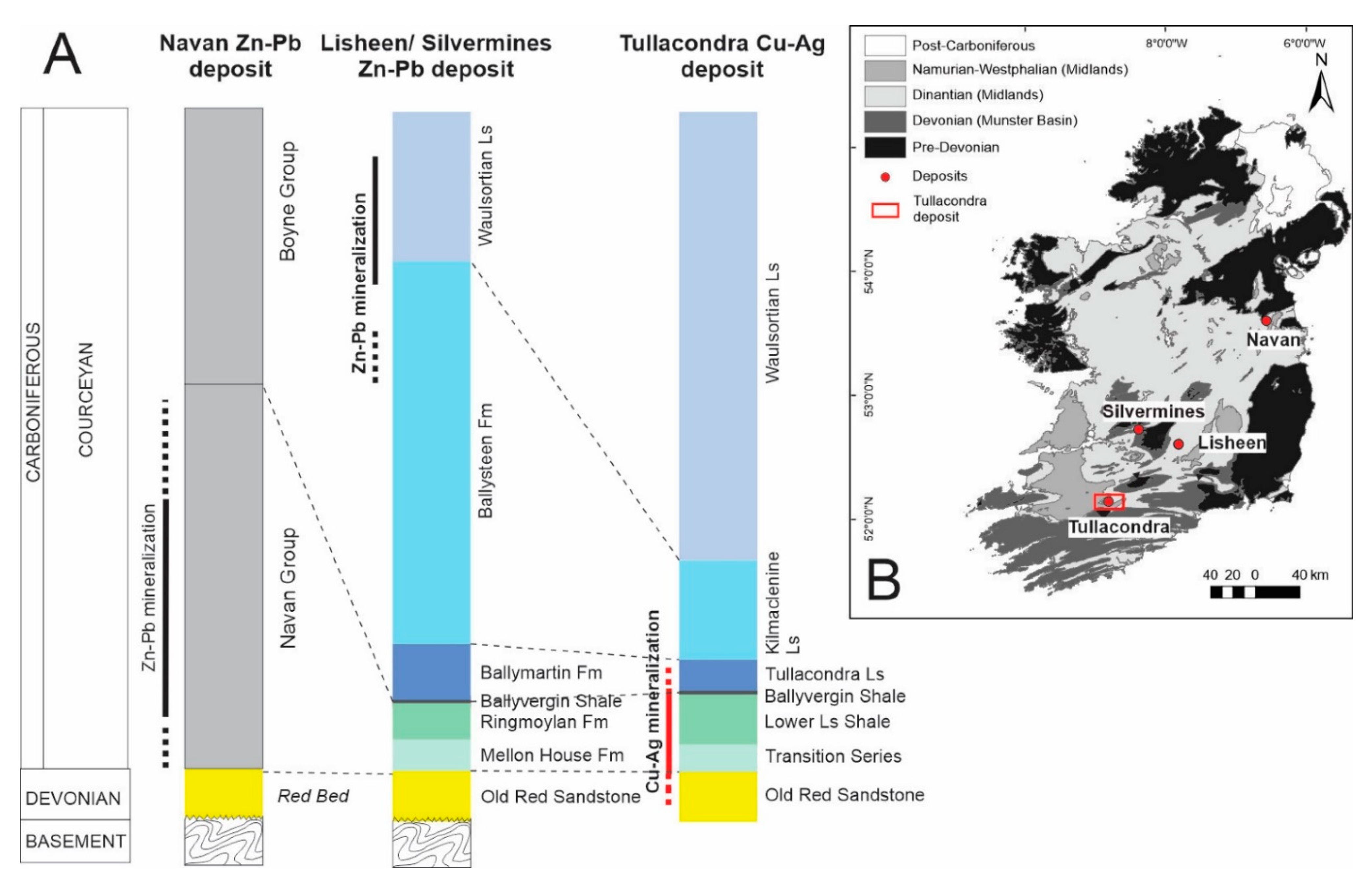
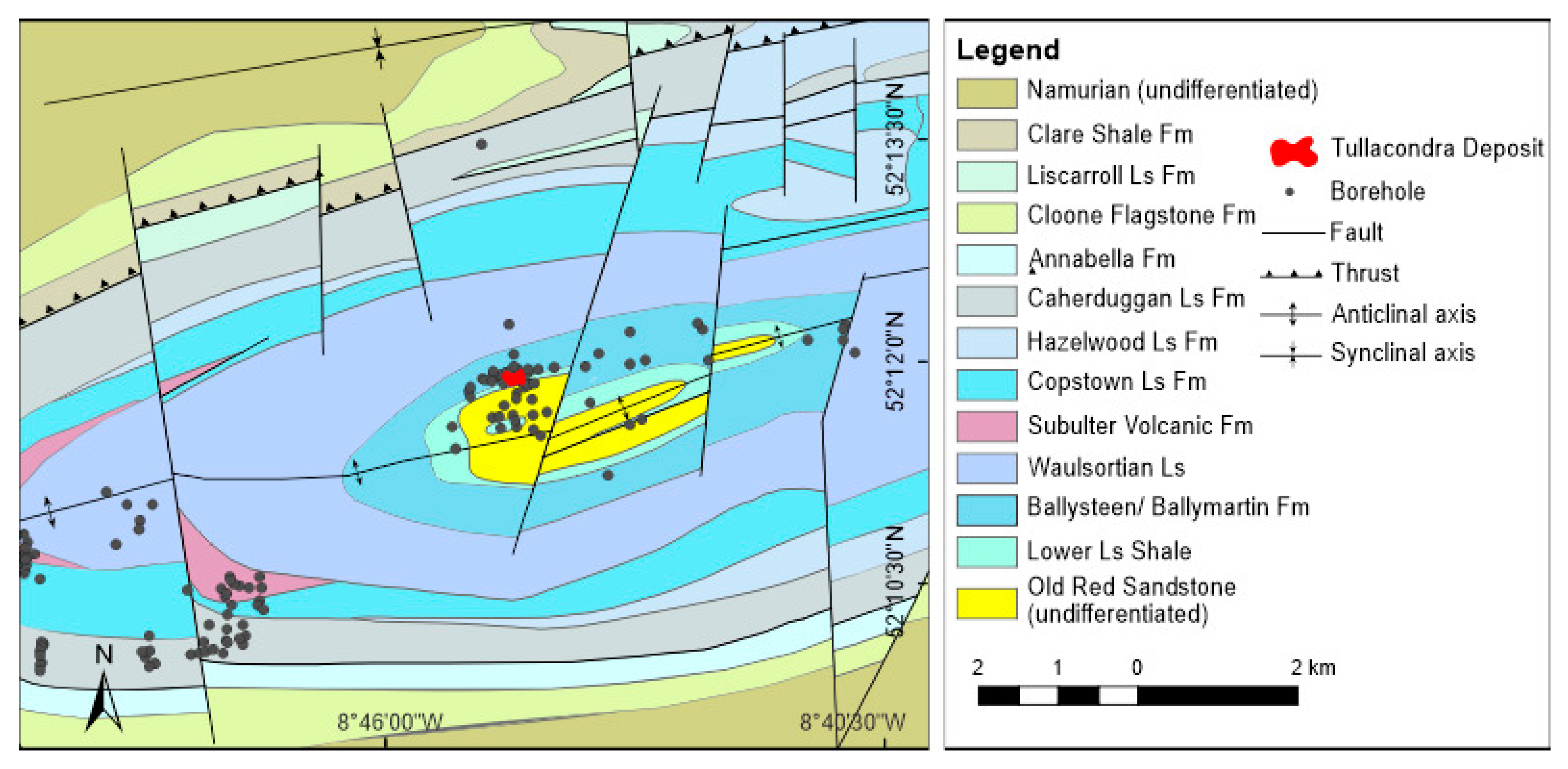

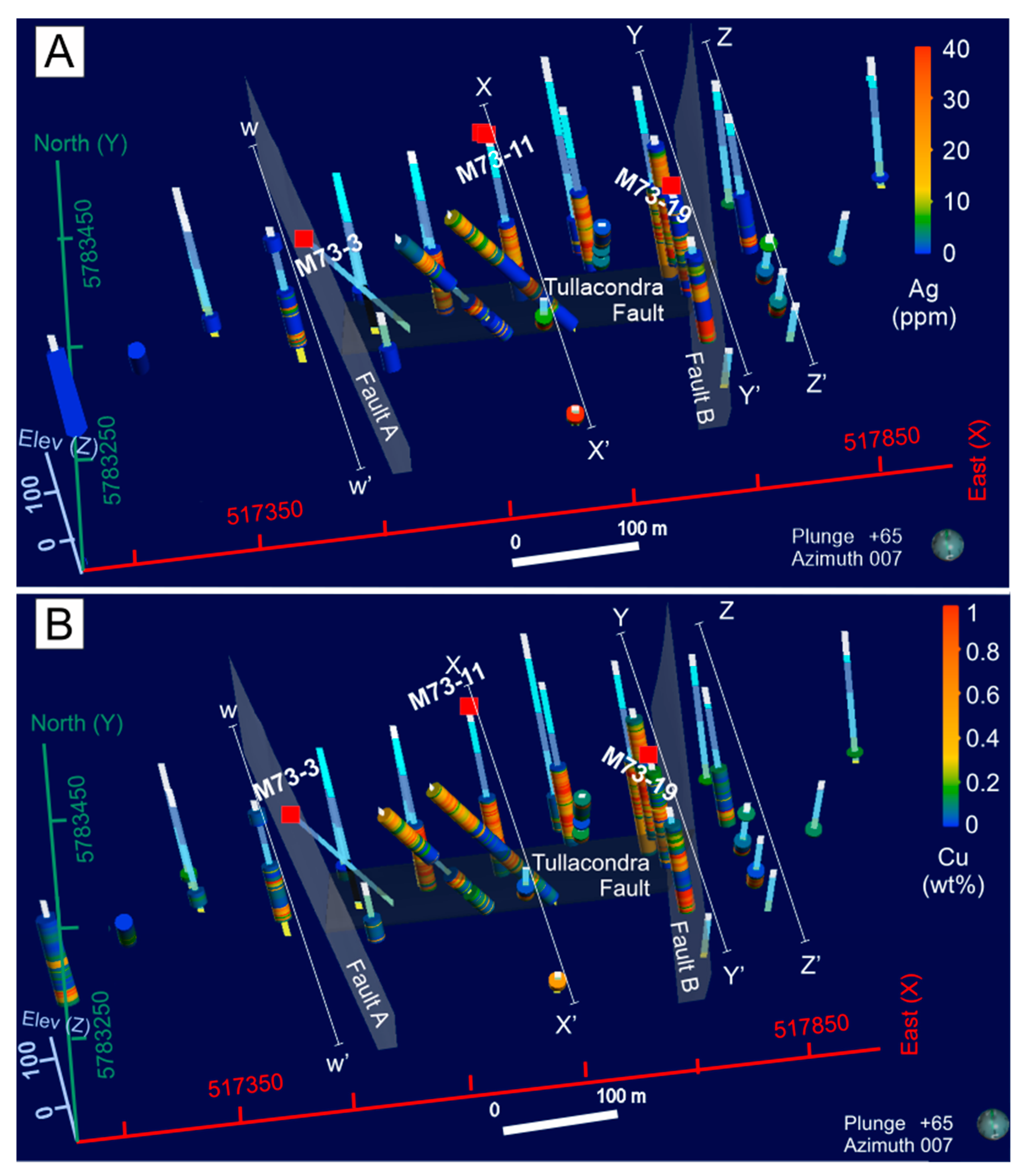
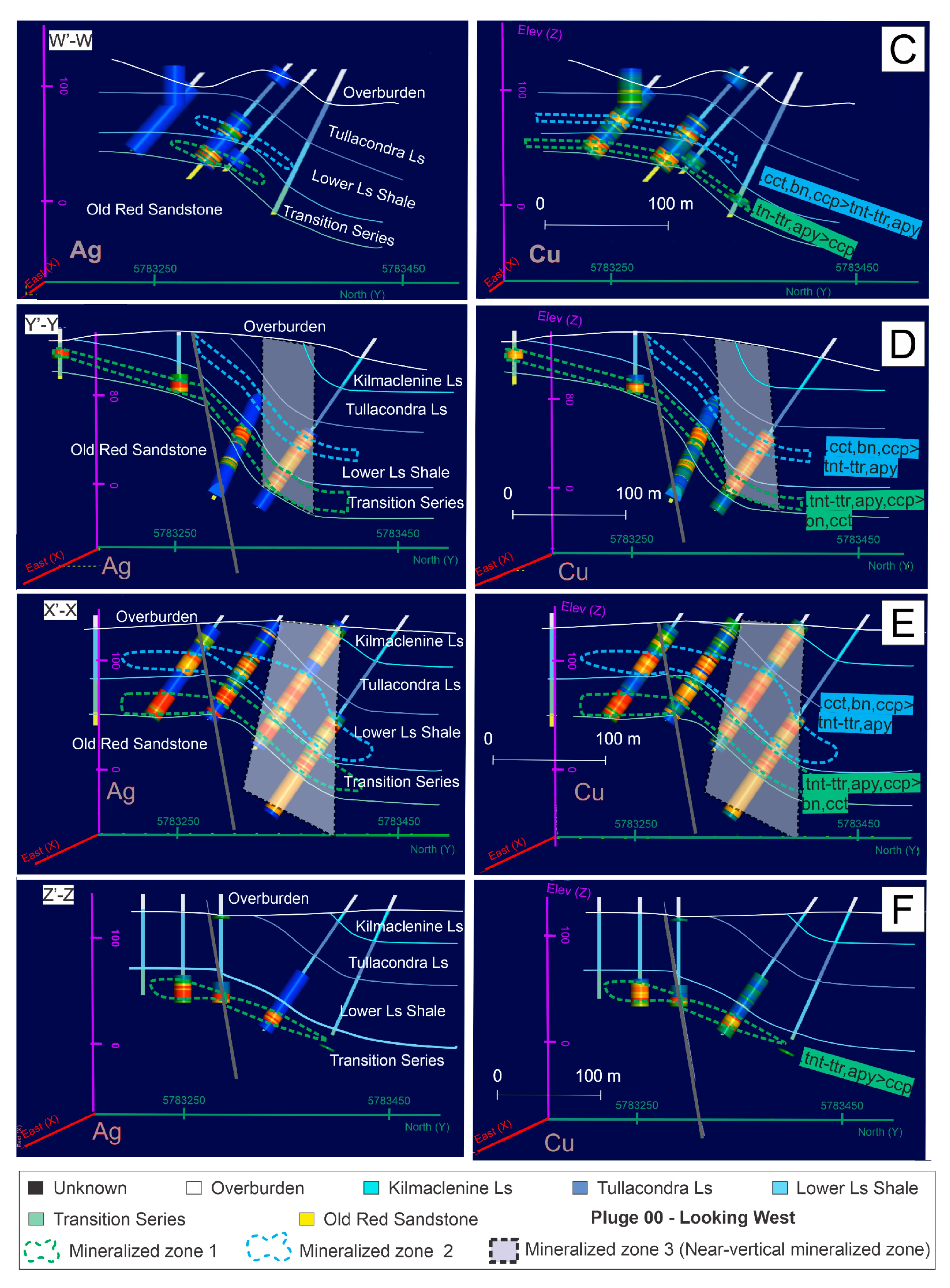
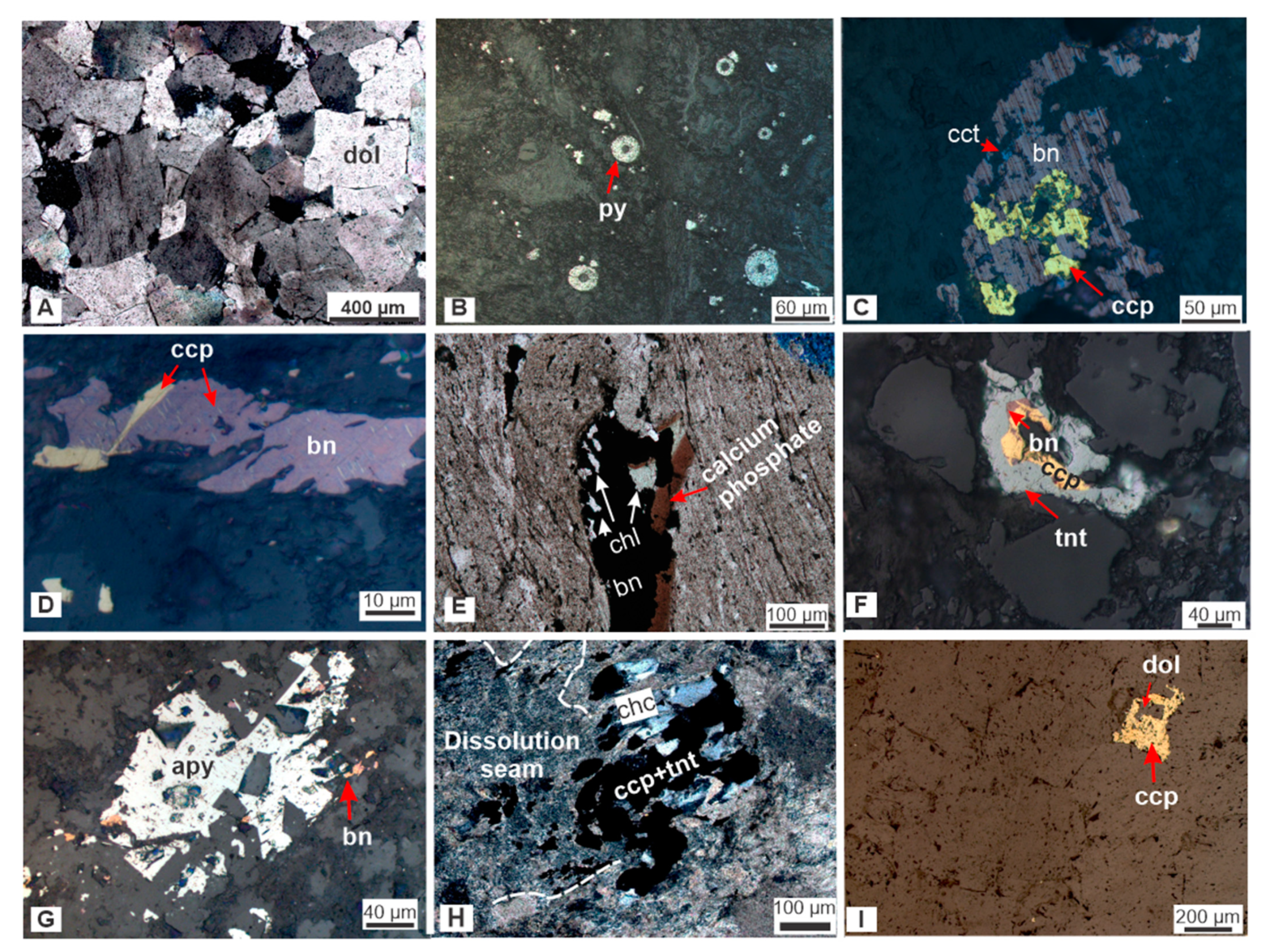
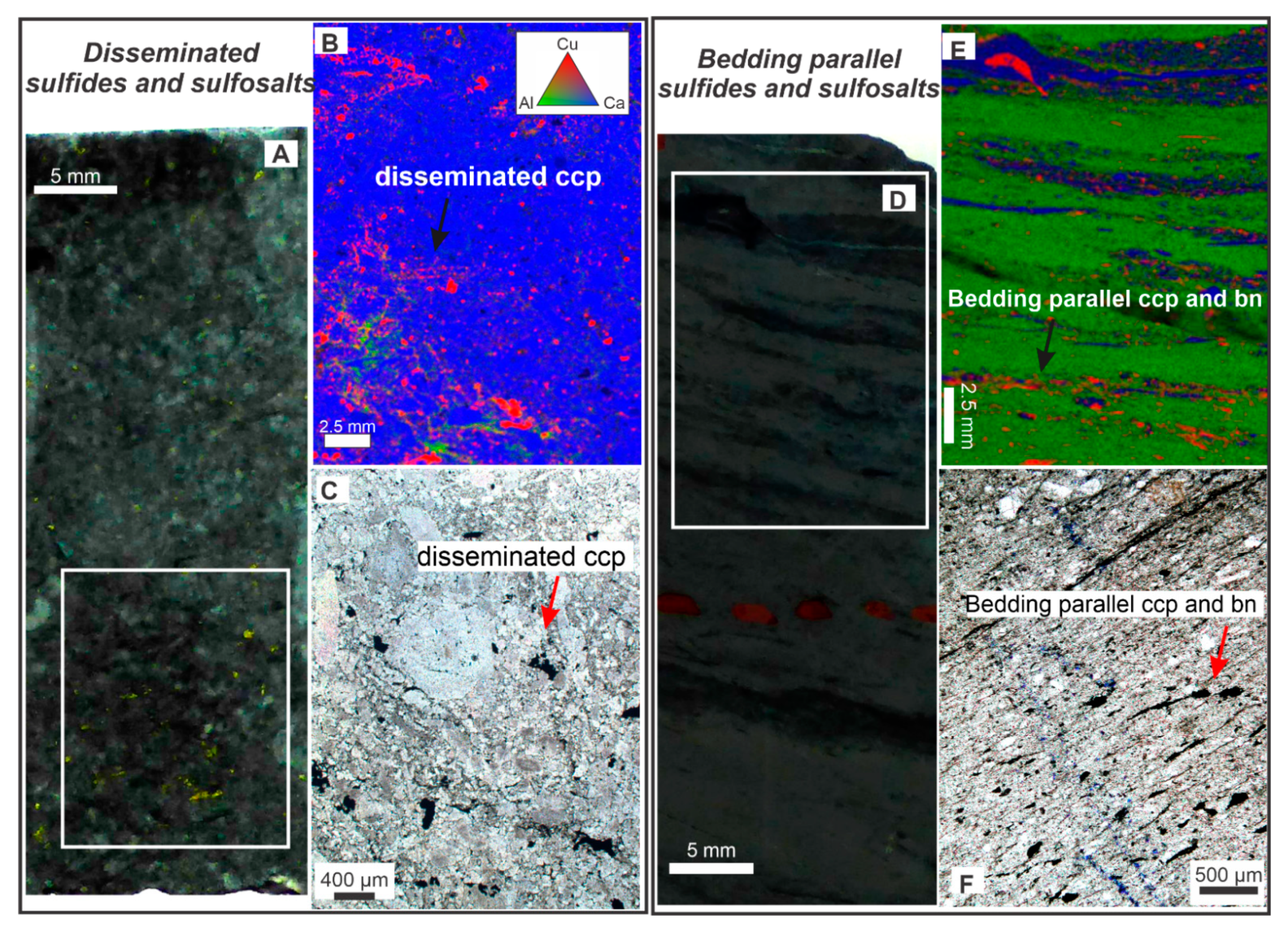
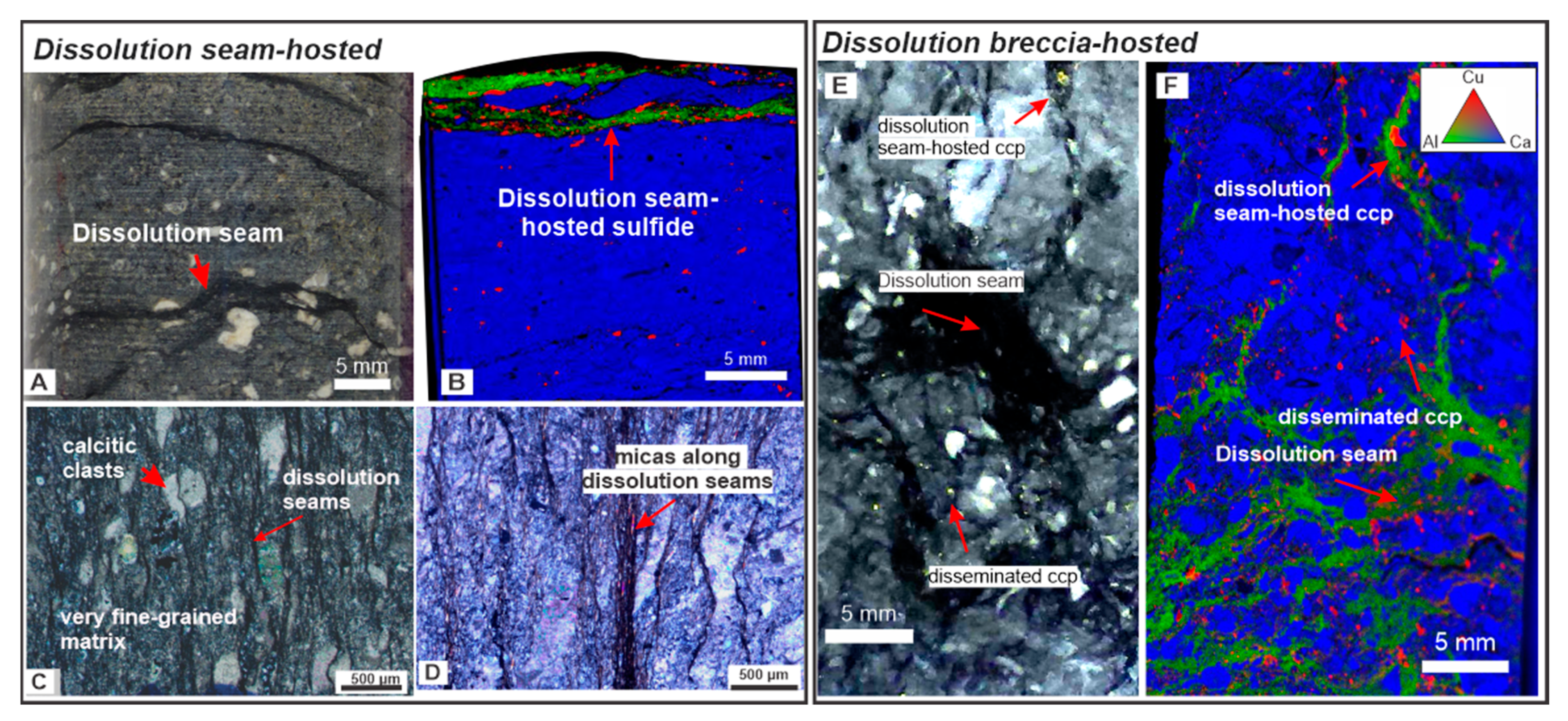
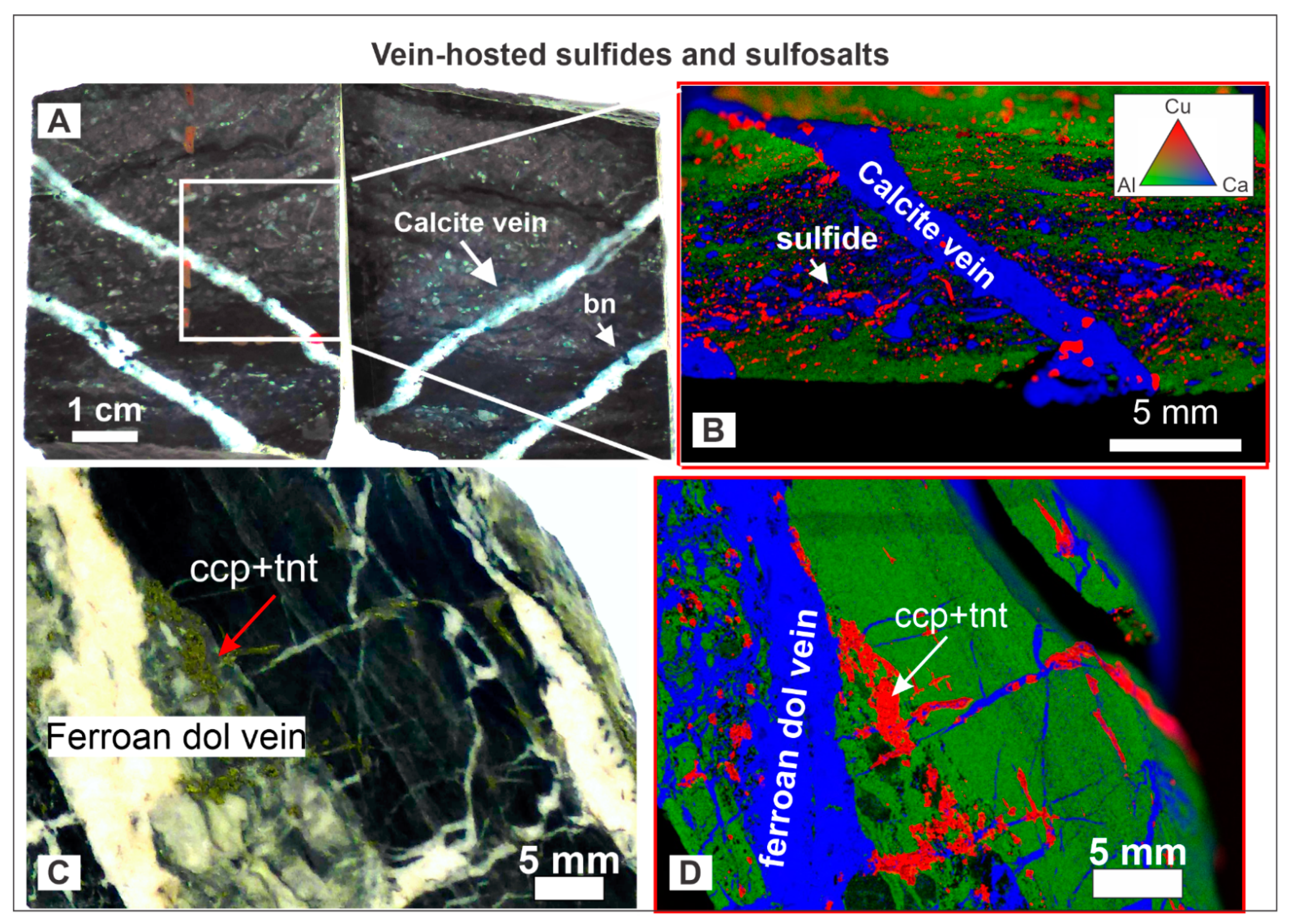
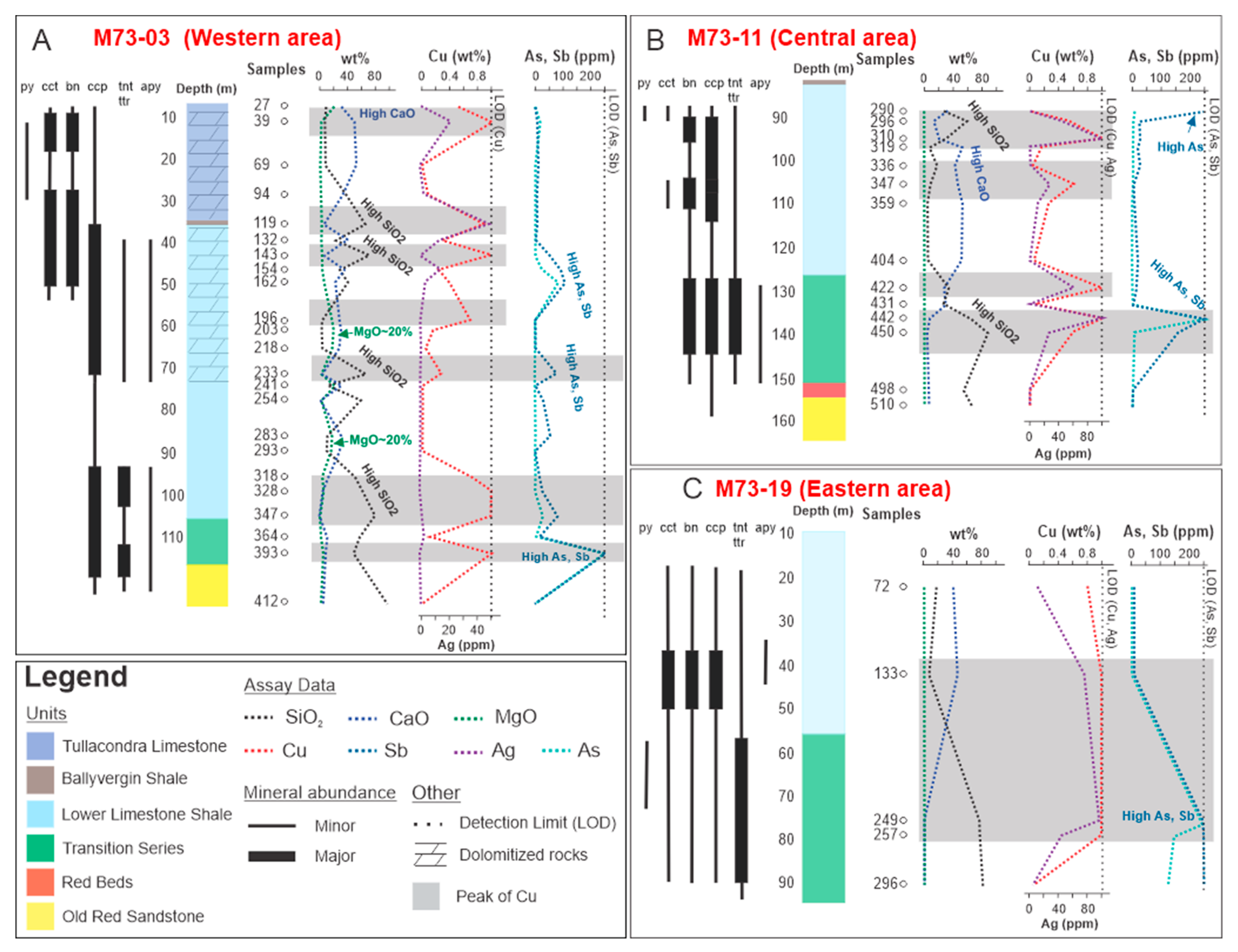
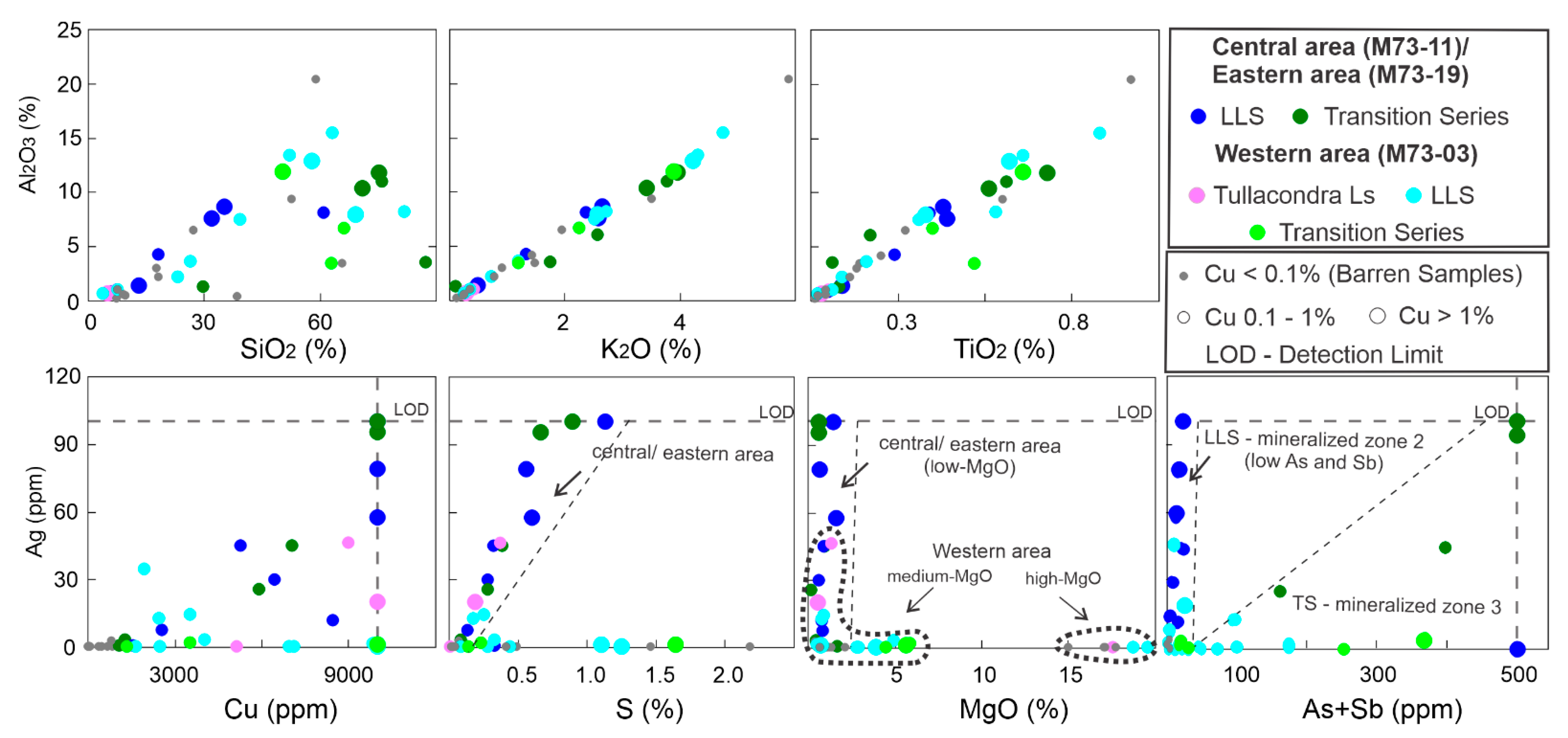

Publisher’s Note: MDPI stays neutral with regard to jurisdictional claims in published maps and institutional affiliations. |
© 2021 by the authors. Licensee MDPI, Basel, Switzerland. This article is an open access article distributed under the terms and conditions of the Creative Commons Attribution (CC BY) license (https://creativecommons.org/licenses/by/4.0/).
Share and Cite
Silva, A.A.; Cordeiro, P.; Johnson, S.C.; Lagoeiro, L.E.; Corcoran, L.; Simonetti, A.; Meere, P.A.; Unitt, R.; Colaço, L.S.; Santos, A.M. The Carbonate-Hosted Tullacondra Cu-Ag Deposit, Mallow, Ireland. Minerals 2021, 11, 560. https://doi.org/10.3390/min11060560
Silva AA, Cordeiro P, Johnson SC, Lagoeiro LE, Corcoran L, Simonetti A, Meere PA, Unitt R, Colaço LS, Santos AM. The Carbonate-Hosted Tullacondra Cu-Ag Deposit, Mallow, Ireland. Minerals. 2021; 11(6):560. https://doi.org/10.3390/min11060560
Chicago/Turabian StyleSilva, Andressa A., Pedro Cordeiro, Sean C. Johnson, Leonardo E. Lagoeiro, Loretta Corcoran, Antonio Simonetti, Patrick A. Meere, Richard Unitt, Laisa Stingelin Colaço, and Anderson M. Santos. 2021. "The Carbonate-Hosted Tullacondra Cu-Ag Deposit, Mallow, Ireland" Minerals 11, no. 6: 560. https://doi.org/10.3390/min11060560
APA StyleSilva, A. A., Cordeiro, P., Johnson, S. C., Lagoeiro, L. E., Corcoran, L., Simonetti, A., Meere, P. A., Unitt, R., Colaço, L. S., & Santos, A. M. (2021). The Carbonate-Hosted Tullacondra Cu-Ag Deposit, Mallow, Ireland. Minerals, 11(6), 560. https://doi.org/10.3390/min11060560








